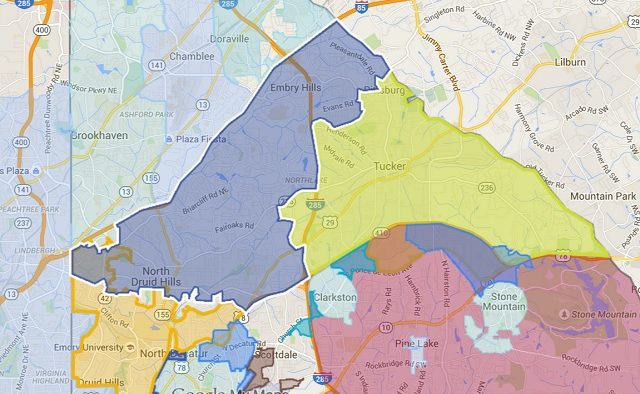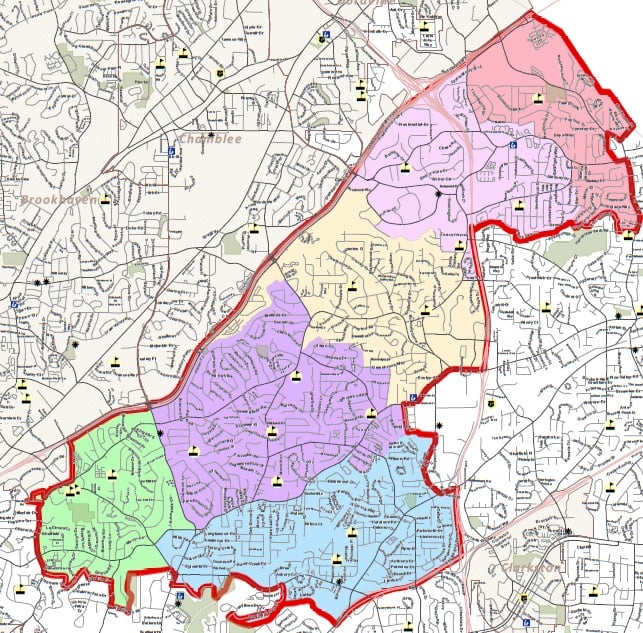(UPDATED) Report claims LaVista Hills isn’t financially feasible
 A map o the proposed city of L
A map o the proposed city of L
This story has been updated.
The Atlanta Journal Constitution has published a report suggesting flaws in a study that concluded the proposed new city of LaVista Hills would take in enough tax money to provide services.
This suggestion isn’t new. Questions about the study began circulating in May, but were dismissed by LaVista Hills supporters.
However, LaVista Hills appears to have put out its own contradictory data regarding a potential tax surplus.
The AJC concluded that instead of a $1.7 million surplus claimed in one feasibility study, LaVista Hills will actually run a deficit of $114,000. The article cites Russell Carleton, who the AJC identifies as a researcher who lives in the LaVista Hills area.
To see a spreadsheet detailing the AJC’s analysis, click here.
Carleton posted his analysis on the DeKalb Strong Facebook page. DeKalb Strong is a group working to oppose cityhood, though membership in the group doesn’t imply support for the group. (Decaturish follows the group as well, and also follows the Facebook pages for the proposed cities of Tucker and LaVista Hills.)
The AJC story also concluded that the analysis for Tucker, another proposed city in DeKalb, remains valid because it was based on a lower tax rate than LaVista Hills.
According to the AJC story, the enabling legislation that put the proposed city on the Nov. 3 ballot uses a lower tax rate than the one used to develop the financial feasibility study. The feasibility study was conducted by the Carl Vinson Institute of Government.
The CVI study assumes a millage rate of 7.64 mills for LaVista Hills. But the LaVista Hills enabling legislation caps the millage at 5 mills.
Carleton is also a Decaturish reader and emailed similar observations about the LaVista Hills budget back in May.
[adsanity id=28156 align=aligncenter /]
“They forgot to tell CVI about their property tax cap, and their revenue estimates are based on a millage of (7.64), when by their own charter, the maximum that they can charge is 5.00,” Carleton wrote to Decaturish in May. “Even if you assume that they set the initial millage at 5.00, their revenue estimate falls by $4 million, turning their $1.7 million surplus into a $2.3 million deficit.”
His conclusions, which were originally posted on DeKalb Strong’s website, alarmed Allen Venet, president of LaVista Hills Yes, who quickly emailed CVI seeking clarification.
“Please see the posting below from the website of the chief anti-city group, so called DeKalb Strong,” Venet wrote to CVI in May. “Are these criticisms valid? Do they risk our status as being feasible? Can we talk sometime this afternoon?”
[adsanity id=27331 align=aligncenter /]
When Decaturish contacted LaVista Hills supporters in May about Carleton’s conclusions, Venet forwarded a response from Ted Baggett, an associate director with CVI. In a nutshell, Baggett said Carleton is comparing two different things.
“A county millage rate is not equivalent to a city millage rate in this context,” Baggett said. “A city millage rate does not come with the HOST county property tax rollback or the applicable county homestead exemptions. Thus a lower city millage rate will generate more revenue than DeKalb County’s millage rate. It compares apples to oranges.”
Decaturish forwarded that response to Carleton.
“Fair enough,” Carleton replied in a May 15 email. “A little shocking that he had to go back for clarification, but such as it is.”
And that’s where the conversation ended, until the AJC published its article on Sept. 14.
Decaturish has reached out to Carleton, and will update this story when he responds.
The questions surrounding LaVista Hills’ financial viability are echoes of the confusing process that led to the approval of the cityhood bill. The LaVista Hills cityhood movement combined the former Briarcliff and Lakeside movements. Both had completed independent feasibility studies before the two groups merged. A new study was not required for the LaVista Hills bill to move forward in the legislature. LaVista Hills released its updated feasibility study in May, after bills for Tucker and LaVista Hills were approved by the General Assembly.
After the session ended, the LaVista Hills movement split into two camps: the LaVista Hills Alliance and LaVista Hills Yes.
Both groups published feasibility studies on their websites showing two different surpluses.
LaVista Hills Yes posted the study with the most-cited surplus of $1.7 million. But the LaVista Hills Alliance posted a study that shows a projected surplus of $2.4 million.
LaVista Hills Alliance appears to have updated its website on Monday evening to link to the study projecting the $1.7 million surplus. To see the cached version of the website linking to the study projecting the $2.4 million surplus, click here.
Venet said the questions raised by Carleton’s analysis and the AJC story are not new and they’ve been answered. He couldn’t address the discrepancies between the different studies posted on the LaVista Hills Yes and LaVista Hills Alliance websites.
“I do not think that there is anything new in Carleton’s charges,” Venet said. “I believed that he raised these very issues before. We went back to CVI, and CVI assured us that his analysis was wrong and that they stick by their conclusion that LaVista Hills is economically viable. I don’t know if there is an error on one of the websites, but I can assure you that there is only one CVI study.”
Here are the two studies, for comparison:
LaVista Hills Alliance CVI LaVista Hills Yes CVI
Both CVI studies show a sharp drop from what LaVista Hills supporters were projecting back in January. During a meeting at Young Israel, the cityhood group told voters the projected surplus would be $6.8 million.
Here Carleton’s his most recent analysis, which he posted to the DeKalb Strong Facebook page on Monday afternoon …
Motor vehicle taxes
CVI revenue estimate: $412,498 (again, assumes a rate of 7.64)
Revenue at 5.00: $269,959
Difference: $142,539Intangible Taxes
CVI estimate: $181,442
Taxed at 5.00: $118,745
Difference: $62,697Personal Property Taxes
CVI estimate: $1,151,027
Taxed at 5.00: $753,290
Difference: $397,737For real property taxes, CVI doesn’t break out the income for residential vs. commercial/industrial, but they do give a breakdown of the assessed value, and they list the estimated revenue from all real property taxes at $11,690,718
Again, from above:
Assessed value of commercial and industrial properties: $693,277,003
Taxed at 7.64: $5,296,636
Taxed at 5.00: $3,466,385For residential properties, the total assessed value is given as $1,921,091,263 and there are 19,775 residential parcels in the city’s footprint (source: https://decaturish.com/…/ProposedLavistaHillsBoundar…)
Other calculations showed that 90 percent of houses were eligible for a homestead exemption (I can show you that one if you want).
90 percent of the digest is worth $1,728,982,137. Subtract out the one mill exemption ($345,796,427) and the 17,797 (and a half!) flat $10k homestead exemptions ($177,975,000) and a total of $523,771,427 is exempt from taxation. Taxed at a rate of 5.00, it produces $6,026,054 in revenue.
The remaining 10 percent of the residential digest does not qualify for an exemption and is worth $192,109,126. Taxed at 5.00, it raises $960,546.
CVI estimates:
Motor vehicle: $412,498
Intangible: $181,442
Personal property: $1,151,027
Real property: $11,690,718Sum: $13,435,685
Revenue if taxed at 5.00
Motor vehicle: $269,959
Intangible: $118,745
Personal: $753,290
Commercial: $3,466,385
Residential (homestead eligible): $6,026,054
Residential (non-homestead): $960,546Sum: $11,594,978
Difference between CVI estimates and 5.00 adjustment: $1,840,707. Difference from the reported surplus ($1,726,682): $114,025
The early version of the AJC story lists the projected deficit at $197k. I’ve notified Mr. Niesse about the error.

